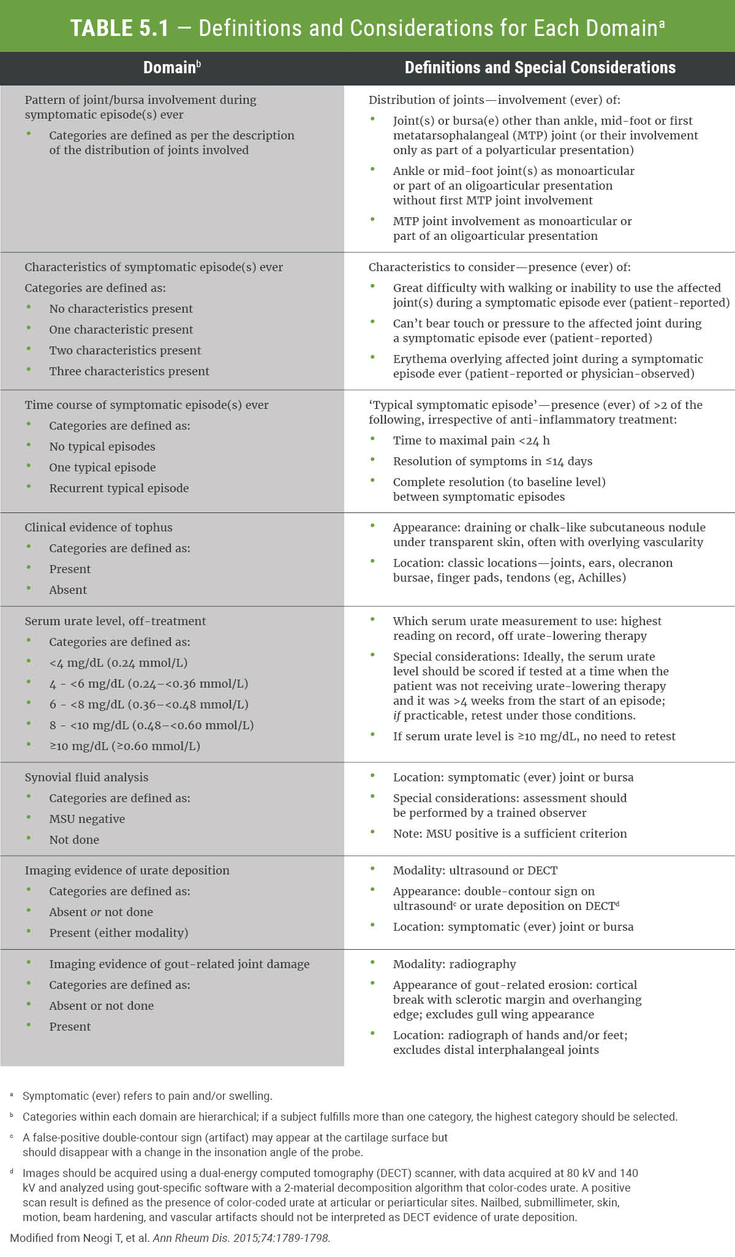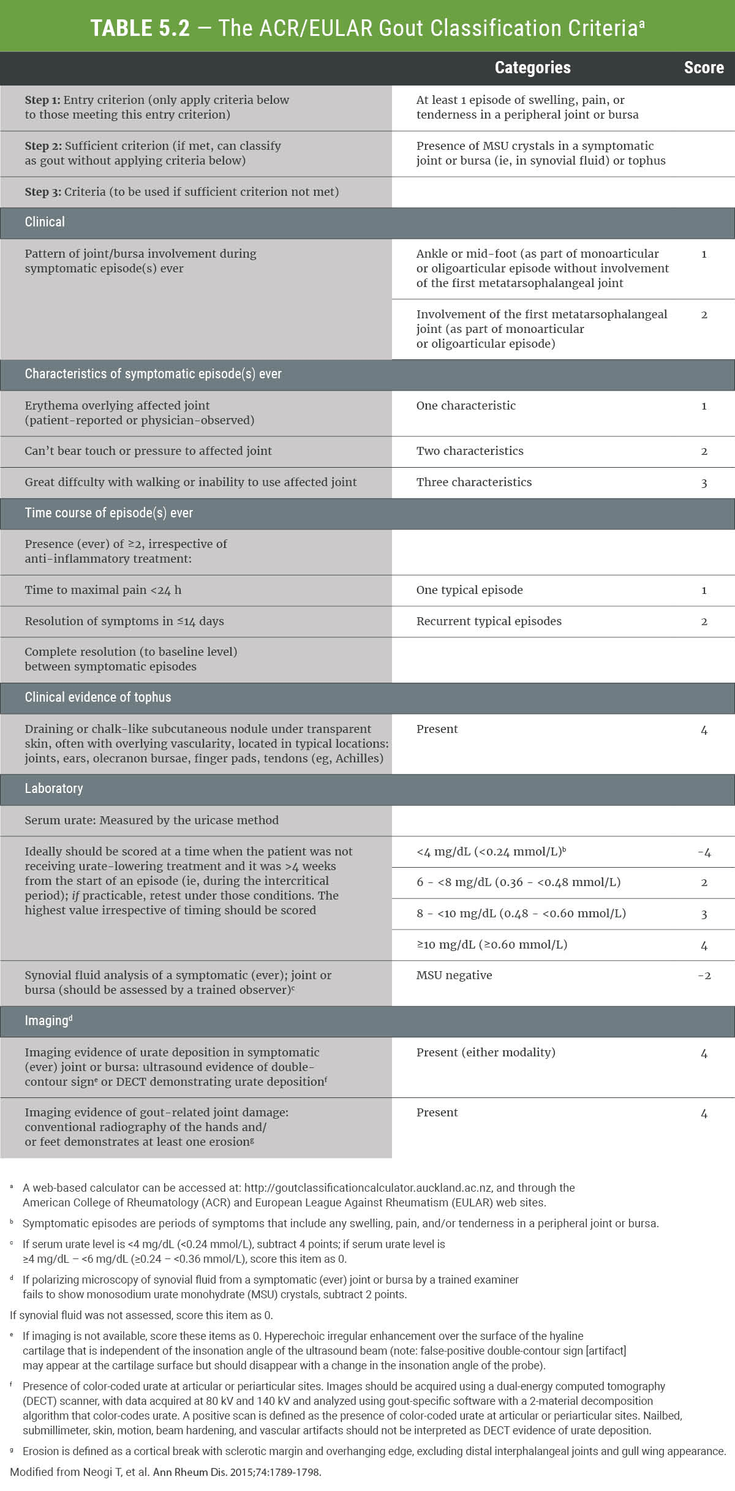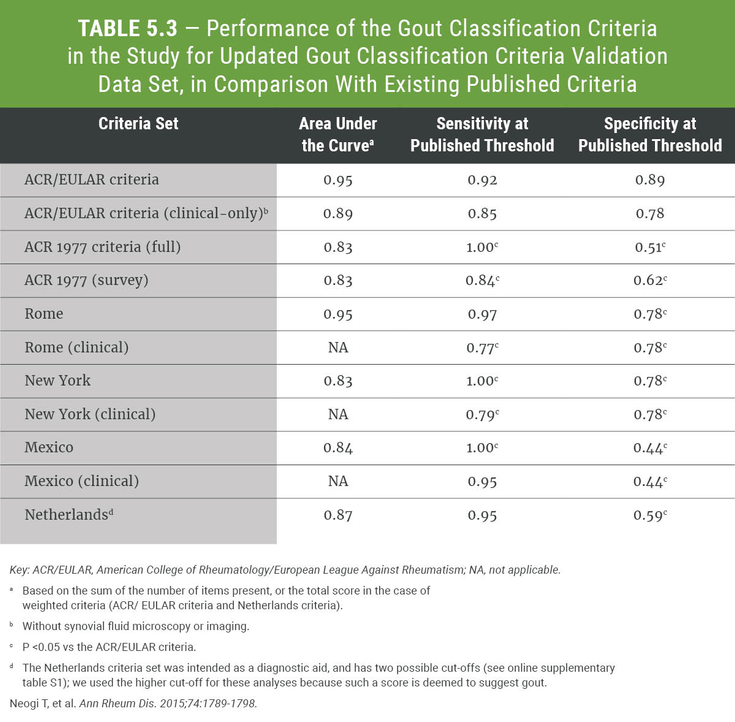Synopsis and Assessment of the 2015 Gout Classification Criteria
American College of Rheumatology/European League Against Rheumatism Collaborative Initiative
The 2015 ACR/EULAR collaboration in gout classification was formed because prior gout classification criteria had substantial limitations in sensitivity and/or specificity. They had been developed using criteria from plain radiographic evidence that is insensitive in recognizing early disease. In the past decade, advanced imaging of urate crystal deposition by ultrasound and dual energy CT (DECT) has revolutionized diagnosis of gout. The ACR and EULARjointly assembled an international group of investigators who performed a systematic review on advanced imaging for gout and carried out a diagnosis study that used palpable tophi, or urate crystals detected in joint fluid, as gold standard. The investigators performed a ranking exercise of files assembled from patient cases and carried out a multi-criterion decision analysis exercise. In doing so, they developed and validated the classification…
To continue reading
Log in or register to continue reading. It's free!
OR
By signing up to create an account, I accept Healio's Terms of Use and Privacy Policy.
American College of Rheumatology/European League Against Rheumatism Collaborative Initiative
The 2015 ACR/EULAR collaboration in gout classification was formed because prior gout classification criteria had substantial limitations in sensitivity and/or specificity. They had been developed using criteria from plain radiographic evidence that is insensitive in recognizing early disease. In the past decade, advanced imaging of urate crystal deposition by ultrasound and dual energy CT (DECT) has revolutionized diagnosis of gout. The ACR and EULAR jointly assembled an international group of investigators who performed a systematic review on advanced imaging for gout and carried out a diagnosis study that used palpable tophi, or urate crystals detected in joint fluid, as gold standard. The investigators performed a ranking exercise of files assembled from patient cases and carried out a multi-criterion decision analysis exercise. In doing so, they developed and validated the classification criteria.
Importantly, the investigators used an “entry criterion” for the new classification criteria. Entry required at least one “episode of peripheral joint or bursal swelling, pain, or tenderness.” Alternatively, urate crystal detection at a symptomatic joint or bursal locus or in a palpable tophus was sufficient for classification as gout and obviated the need for further scoring. Sensitivity and specificity of the criteria were high (92% and 89%, respectively), reflecting the unique multi-domain nature of the criteria, which spanned clinical features, lab findings (serum urate and results of crystal analysis of joint fluid) and imaging findings (ultrasound, DECT, or gouty erosion on plain radiography).
The following tables and figures extracted from the manuscript were key elements of the new classification criteria. First, Table 5-1 summarizes the definitions and considerations for each domain used for diagnosis of gout. Figure 5-1 shows examples of palpable tophi that the reviewers used as a reference standard, and Figure 5-2 shows the reference standards of imaging findings used.
Table 5-2 lays out the gout criteria individually, with the scoring system that weighs each criterion. The hotlink to the calculator for the index can be found at http://goutclassificationcalculator.auckland.ac.nz and is shown in Figure 5-3. Table 5-3 displays the results for performance characteristics of the 2015 ACR/EULAR gout classification criteria, compared to results for the previously published criteria.
The performance characteristics of the 2015 ACR/EULAR gout classification criteria, which took into account sensitivity and specificity, were superior to all prior published criteria for gout diagnosis.



Take-Away Messages
(Summary assessment of the 2015 ACR/EULAR gout classification criteria)
- Advantages
- Data-drive, state of the art, clear decision-analytic approach
- Derived from medical records from multiple international clinical practices
- Includes ultrasound and DECT assessment for urate crystal deposition, and plain radiographic assessment of gouty erosion
- Excellent performance characteristics in the original study:
- Sensitivity 92%
- Specificity 89%
- Superior performance characteristics to all prior published gout diagnosis criteria
- Limitations
- Full prospective validation lacking for all clinical practices
- Applicability to primary care is currently particularly limited by lack of generalized availability of high resolution diagnostic musculoskeletal ultrasound and/or DECT
- The assignment of equal weights (4 points each) to finding of a palpable tophus, to the ultrasound double contour sign and to a positive DECT can be questioned (especially for diagnosis of acute gout in early disease, based on initial literature)
- The only ultrasound criterion was a positive “double contour” sign for urate crystal deposition on the articular cartilage surface:
- This finding is most frequent in the first metatarsophalangeal joint, and less frequent in more proximal joints and upper extremity joints
- Hyperechoic aggregates on ultrasound, indicative of articular tophaceous disease, was not a criterion in this classification of gout diagnostic tools.
- Most useful at present as a new standard for inclusion criteria for definition of disease to be used in clinical research, including clinical trials (as emphasized by the authors of the gout classification criteria)
References
- Terkeltaub R, Edwards NL, Khanna P. Gout: Diagnosis and Management of Gouty Arthritis and Hyperuricemia. 5th ed. Professional Communications Inc. 2024
- Neogi T, Jansen TL, Dalbeth N, et al. 2015 Gout Classification Criteria: an American College of Rheumatology/European League Against Rheumatism collaborative initiative. Arthritis Rheumatol. 2015;67(10):2557-2568.
- Taylor WJ, Fransen J, Jansen TL, et al. Study for updated gout classification criteria: identification of features to classify gout. Arthritis Care Res (Hoboken). 2015;67(9):1304-1315.








